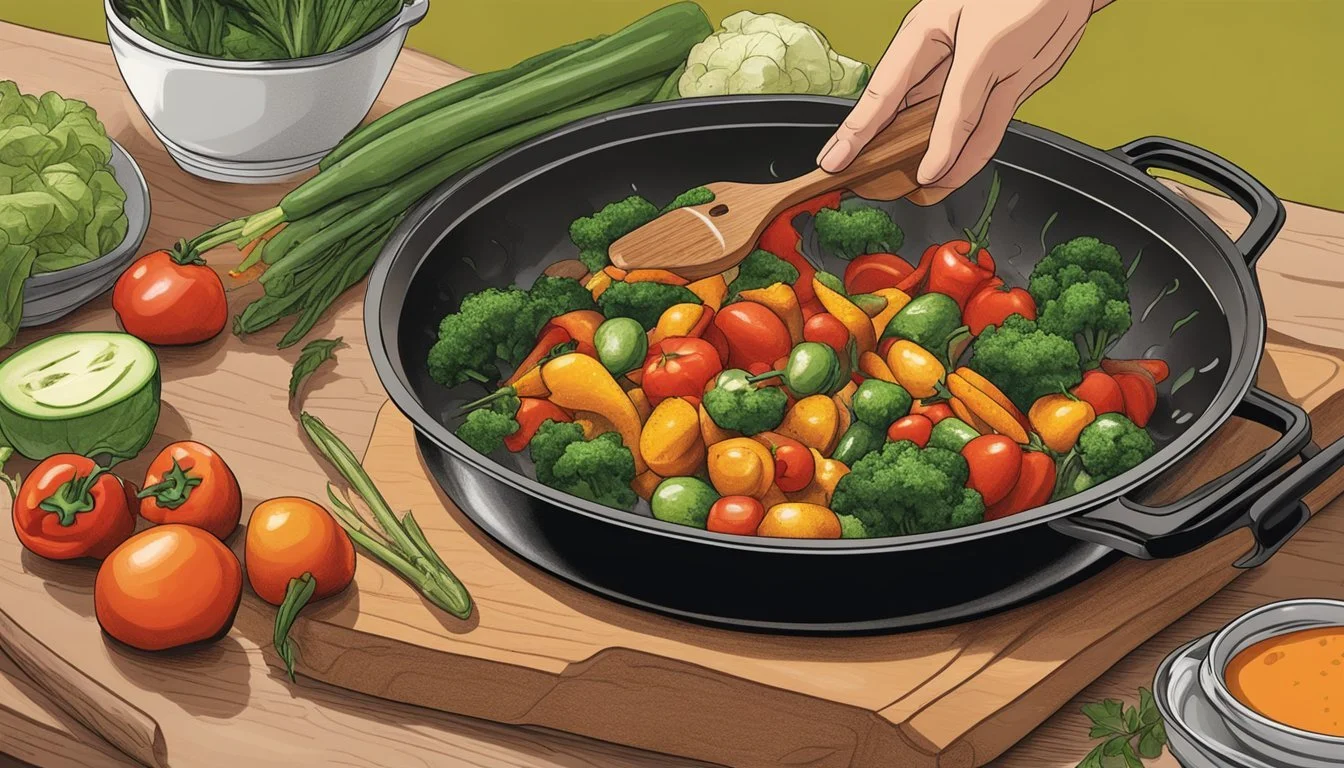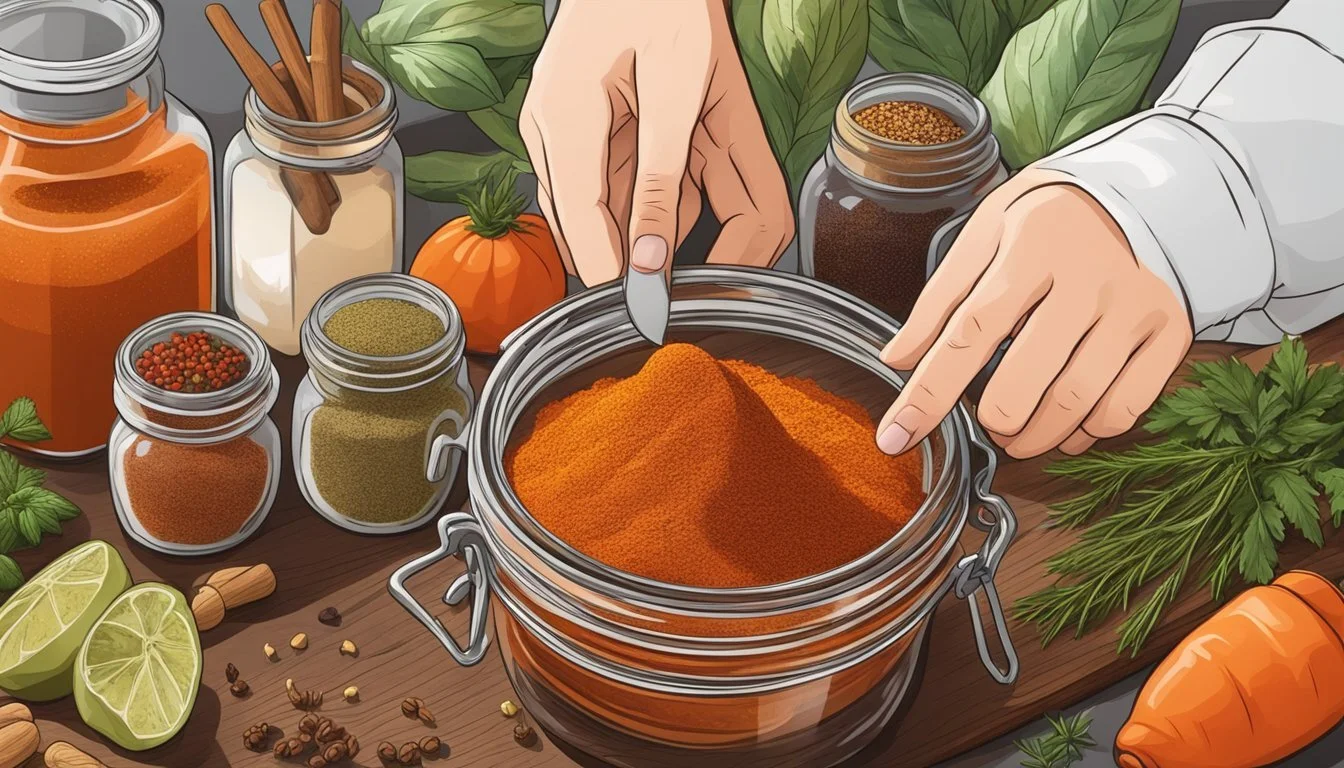Smoked Paprika Substitutes
Best Alternatives and How to Use Them
Finding the right substitute for smoked paprika can elevate your dishes without sacrificing flavor. Chipotle powder and liquid smoke are excellent alternatives that provide a similar smoky essence. If heat is a concern, sweet paprika or powdered guajillo pepper can replace smoked paprika without the added spice.
For recipes requiring the distinct flavor of smoked paprika, ancho chili powder or smoked sea salt offer a close match. Each substitute brings its own nuance, allowing for customization based on the dish's requirements. Understanding these options ensures that any recipe calling for smoked paprika can still be executed to perfection.
Experimenting with these substitutes can lead to delightful culinary discoveries. The array of options means that whether you need an exact match or a creative twist, there's a solution at hand.
What Is Smoked Paprika?
Smoked paprika, also known as pimentón, is a type of spice derived from dried and smoked red peppers. This spice is particularly popular in Spanish cuisine, where it is used to add depth and a smoky flavor to various dishes.
The process of making smoked paprika involves drying the red peppers over an oak wood fire. This imparts a rich, smoky aroma and flavor to the final product.
There are different varieties of smoked paprika, including sweet (dulce), bittersweet (agridulce), and hot (picante). Each type has its own unique flavor profile, making smoked paprika a versatile ingredient in the kitchen.
While Spanish paprika is the most well-known, Hungarian paprika can also be found in different grades, though it typically lacks the smoky component unless specifically smoked.
Using smoked paprika in recipes can enhance the overall flavor, adding a distinct smoky note that complements dishes ranging from meats to stews and even certain vegetable preparations.
In summary, smoked paprika is a versatile and aromatic spice, integral to many culinary traditions, especially in Spain. Its smoky depth and vibrant color make it a sought-after ingredient in various recipes, both traditional and contemporary.
Characteristics of Smoked Paprika
Smoked paprika is a distinctive spice known for its smoky flavor, deep red color, and variable heat levels. These characteristics make it a versatile ingredient in various recipes.
Flavor Profile
Smoked paprika delivers a smoky flavor that infuses dishes with a robust, slightly sweet taste. The smokiness comes from the peppers being dried over oak fires before they are ground into a fine powder.
The underlying sweetness of smoked paprika makes it different from regular paprika. While it retains some sweetness, the primary appeal is its intense smoky flavor.
Smoked paprika is often used in Spanish cuisine, imparting a signature smokiness to dishes like chorizo and paella. Its distinct taste can elevate even simple recipes.
Color and Texture
The color of smoked paprika is a rich, deep red, which can significantly enhance the visual appeal of dishes. This vibrant color comes from the specific variety of peppers used and the drying process over oak wood.
In terms of texture, smoked paprika is finely ground, making it easy to blend seamlessly into sauces, soups, and rubs. Unlike some coarser spices, it dissolves well, allowing for an even distribution of color and flavor.
The powder consistency ensures it mixes well with other ingredients, providing uniformity in spice blends and seasonings. Its vivid hue can be used to garnish or as a primary seasoning.
Heat Levels
Smoked paprika comes in different heat levels, which can range from mild to hot. Sweet paprika has no heat and focuses more on the smoky and sweet notes.
Hot paprika adds a noticeable kick, providing a balance between smokiness and spicy heat. The variability in heat levels allows cooks to choose the right type based on the dish they are preparing.
Whether looking for a mild smoky flavor or a spicy kick, smoked paprika offers flexibility. Its different heat levels make it suitable for a wide range of culinary applications, from mild stews to spicy marinades.
Culinary Uses
Smoked paprika, with its unique smoky flavor, finds its way into various traditional and modern dishes, adding depth and complexity. It is particularly popular in Spanish and Mexican cuisines.
Traditional Dishes
In Spanish cuisine, smoked paprika is vital in recipes such as chorizo, where it lends a smoky, rich flavor to the sausage. It is also commonly used in stews and soups, like the famous Spanish dish, Sopa de Ajo (Garlic Soup), enhancing their depth and warming quality.
Mexican dishes also benefit significantly from smoked paprika. It is often added to salsas and marinades, contributing a smoky, earthy note that complements other bold spices. Ancho pepper powder or Chipotle powder are good substitutes in these recipes, maintaining that desired smokiness.
Modern Kitchen
In contemporary cooking, smoked paprika's versatility shines. It can be incorporated into sauces, providing an extra layer of flavor. When added to marinades, it offers a robust taste that pairs well with meats and vegetables.
In the context of breakfast and appetizers, smoked paprika elevates simple dishes like deviled eggs and scrambled eggs, giving them a distinctive twist. Sprinkling it on roasted potatoes or over a finished dish adds an appealing color and flavor.
For those looking to experiment, a blend of regular paprika and cumin can mimic the color and some subtleties of smoked paprika. This combination works well in a pinch for adding both warmth and a hint of smokiness to various recipes.
Common Smoked Paprika Substitutes
Smoked paprika adds a distinct smoky flavor to dishes, making it a popular spice in many kitchens. When it's not available, chipotle powder, ancho chili powder, cayenne pepper, and liquid smoke are excellent alternatives that can deliver similar results.
Chipotle Powder and Chipotle Chili Powder
Chipotle powder is crafted from smoked and dried jalapenos. This substitute not only brings the smoky essence of smoked paprika but also introduces a mild to medium spiciness.
Chipotle powder offers a depth of flavor, making it a great addition to dishes requiring a smoky kick. It's versatile and pairs well with meats such as pork or chicken. Chipotle chili powder is a slightly different version but serves the same purpose, bringing both smokiness and heat to recipes.
Ancho Chili Powder and Ancho Pepper Powder
Ancho chili powder comes from dried poblano peppers and is milder compared to chipotle powder. It has a deep, rich flavor with subtle smokiness and a hint of sweetness.
Ancho pepper powder is ideal for those who want a less spicy but flavorful alternative to smoked paprika. This substitute works well in Mexican and Southwestern dishes, enhancing the depth of flavor without overwhelming the palate.
Cayenne Pepper and Cayenne Pepper Powder
Cayenne pepper powder is much spicier than smoked paprika and lacks the smoky element. To mimic the smokiness, combine cayenne with regular paprika in a 2:1 ratio (two parts regular paprika to one part cayenne).
This mixture balances the spiciness of cayenne with the mild sweetness of regular paprika. Ideal for adding heat and color to dishes, it works particularly well in stews, soups, and marinades.
Liquid Smoke and Smoked Sea Salt
Liquid smoke is a concentrated, smoky-flavored liquid and can be used sparingly to add a smoky taste. A few drops can transform any dish, making it a convenient substitute for smoked paprika.
Smoked sea salt also provides smokiness but with an added salty element. It can be sprinkled directly on food or used in cooking to impart a smoky flavor. Both options are excellent for those preferring a non-powdered alternative that still delivers smoky depth.
Other Savory Substitutes
Several alternatives capture the savory essence of smoked paprika. Each offers a unique combination of flavors and can enhance various dishes when smoked paprika is unavailable.
Guajillo Pepper Powder and Powdered Guajillo Pepper
Guajillo pepper powder provides a mild heat with fruity undertones. It is less smoky than smoked paprika but still versatile. Ideal for Mexican-style dishes, it adds depth to stews, chili, and marinades.
This dried pepper can be ground into a fine powder, making it easy to measure and incorporate into recipes. The Ancho pepper, which is similar in flavor, can also serve as a replacement in a pinch.
Sweet Paprika combined with Cumin
Sweet paprika combined with cumin creates a close match to the taste profile of smoked paprika. Use a 2:1 ratio of sweet paprika to cumin to replicate the earthy and smoky notes.
While sweet paprika offers a mild sweetness, cumin adds a rich, aromatic quality. This blend works well in meat rubs, soups, and vegetable dishes to impart a warm, smoky taste.
Tomato Paste with Smoked Spices
A mixture of tomato paste with smoked spices can mimic the richness and smokiness of smoked paprika. Combining tomato paste with a sprinkle of smoked salt, garlic powder, and a pinch of oregano enhances the overall flavor depth.
This option is particularly effective in sauces, stews, and barbecue dishes where a thick, savory consistency is desired. Smoked spices like smoked paprika or chipotle powder can boost the smoky flavor.
Roasted Red Pepper Flakes
Roasted red pepper flakes offer a smoky, sweet heat similar to smoked paprika, without the intense spice. These flakes are made from dried, roasted red bell peppers, providing a more subtle flavor.
They can be sprinkled over pasta, soups, and grilled vegetables to enhance the dish with a gentle smokiness. If a ground texture is preferred, the flakes can be crushed further before adding to recipes.
Creating Unique Flavor Combinations
Creating substitutions for smoked paprika offers a chance to craft distinctive flavor profiles. This involves experimenting with various spices and adjusting flavors to achieve the perfect balance of heat and smokiness.
Experiment with Spices
Diversifying the spice cabinet can lead to many delicious combinations. Using ancho pepper powder introduces a milder, earthy essence similar to smoked paprika.
Adding a sprinkle of Aleppo chili powder brings a blend of smoky, earthy, and tangy notes, making it a versatile option. Blends of herbs like oregano and thyme combined with a touch of smoked salt can also create a woodsy depth.
Creating spice rubs with different layers – such as combining cumin and coriander with chili powders – can form a complex flavor that both complements and enhances the dish without overpowering the other ingredients.
Adjusting Flavors for Heat and Smokiness
Balancing heat and smokiness is key to achieving the desired taste. Chipotle powder, derived from smoked chilies, offers robust heat paired with a smoky undertone. For less heat, reducing the quantity can maintain the smoked flavor without overwhelming the dish.
For a more subtle smokiness, using sweet paprika mixed with a few drops of liquid smoke provides control over the intensity. This combination is ideal for those who prefer a mild spice level while still imparting a touch of smokiness.
Adjusting these flavors allows for tailored taste experiences, ensuring that the smokiness and heat enhance the dish rather than overpowering it.
Understanding the Impact on Recipes
The choice of smoked paprika substitutes can significantly influence the flavor profile of a dish. Specific substitutes work better in certain types of recipes, such as meats and marinades, or vegetarian and vegan alternatives.
Meats and Marinades
For meats and marinades, substitutes like chipotle powder and cayenne with cumin are highly effective. Chipotle powder offers a robust smoky flavor reminiscent of smoked paprika, making it ideal for pork cuts, ribs, and chicken. The spice also adds a slight earthiness which can deepen the overall flavor of meat dishes.
Cayenne and cumin provide a mix of heat and warm undertones. This combination works well in ribs and spicy meat marinades, delivering both the smokiness and the spicy kick required. Using both spices in a 2:1 ratio (cayenne to cumin) ensures a balanced heat and depth of flavor.
Vegetarian and Vegan Alternatives
When cooking vegetarian and vegan dishes, options like sweet paprika with liquid smoke and cayenne chili powder can be valuable alternatives. Sweet paprika with liquid smoke offers a controllable smokiness. Mixing 1 tablespoon of sweet paprika with a few drops of liquid smoke allows for precision in achieving the desired smoky flavor in vegetable-based recipes.
Cayenne chili powder provides both heat and a slight smoky essence. It's useful in chili, sauces, and vegetable roasts. The addition of cayenne enhances the dish without overpowering the intrinsic flavors of vegetables. This makes it ideal for vegan chilis and smoky sauces.
Health and Dietary Considerations
When considering substitutes for smoked paprika, it's important to evaluate caloric and nutritional content, along with any potential allergies and sensitivities. This ensures that the alternative chosen suits both taste preferences and dietary needs.
Caloric and Nutritional Content
Many smoked paprika substitutes like chipotle powder and cayenne with cumin offer distinct flavors—ranging from smoky to slightly spicy. A teaspoon of chipotle powder typically contains about 8 calories, combining the smoky element of jalapenos.
Chipotle Powder:
Calories: 8 per tsp
Flavor: Smoky and earthy
Scoville Scale: 2,500-8,000 SHU
Cayenne and Cumin Mix:
Calories: Roughly 6 calories per tsp
Flavor: Spicy and earthy
Scoville Scale: 30,000-50,000 SHU (Cayenne)
The calorie difference between these substitutes and smoked paprika, which also contains about 6 calories per teaspoon, is minimal. These alternatives can provide similar nutritional benefits, including small amounts of vitamins A and C.
Allergies and Sensitivities
Individuals with sensitivities to nightshades, which include peppers, should be cautious. Both chipotle powder and cayenne with cumin mixes originate from nightshades and may not be suitable.
Nightshade Family Include:
Peppers (like jalapenos and cayenne)
Tomatoes
Eggplants
Common symptoms of nightshade sensitivity can include digestive issues, inflammation, or other allergic reactions. For those with such sensitivities, an alternative like smoked paprika made from non-nightshade sources may be considered. Additionally, monitoring portion sizes can help minimize potential reactions.
A thorough understanding of both nutritional content and potential allergens ensures that substitutes not only match the flavor profile of smoked paprika but also align with individual dietary requirements.
Storing and Preserving Substitutes
Proper storage is essential for maintaining the quality and flavor of spices. Smoked paprika substitutes such as chipotle powder, Aleppo chili powder, and ancho pepper powder should be stored in airtight containers. This prevents moisture and air from degrading their flavors.
Keep these spices in a cool, dark place away from direct sunlight. Exposure to light can cause a loss of potency over time.
Shelf life varies among different spices. For example:
Chipotle powder: Typically lasts 1-2 years.
Aleppo chili powder: Best within a year.
Ancho pepper powder: Retains flavor for around 1-2 years.
Using clear labels with the purchase date can help keep track of their freshness.
When dealing with spice blends, such as a mixture of cayenne and cumin or blends that include paprika, the same storage principles apply. Ensure they are in airtight containers and stored in dark, cool places.
For keeping spices fresh:
Avoid storing near the stove or other heat sources.
Refrain from refrigerating as spices can absorb moisture and odors.
Always use dry utensils to scoop out the spices to prevent contamination. Regularly check for any signs of spoilage or discoloration and replace as needed. This careful handling ensures the flavor and quality of substitutes remain intact over time.
Integrating Substitutes into Global Cuisines
Smoked paprika substitutes can enrich a variety of global dishes. By incorporating alternatives such as chipotle powder, cayenne chili powder, and pimiento powder, cooks can maintain the distinctive flavor profiles central to various cuisines.
Mexican and Tex-Mex
Smoked paprika often plays a supporting role in Mexican dishes, adding depth to tacos, enchiladas, and mole sauces. Chipotle powder is a prime substitute in these cuisines, offering a similar smoky note and complexity.
Tacos benefit from chipotle powder's heat and smokiness, making it a great alternative for seasoning meats and vegetables. Mole sauces, rich and layered, also thrive with the inclusion of chipotle powder, retaining an authentic smoky flavor. Experimenting with blends of ancho or pasilla powders can further deepen the taste.
Indian Curry and Tandoori
In Indian cuisine, smoked paprika substitutes like cayenne chili powder can elevate curry and tandoori dishes. Cayenne brings a smoky heat that complements the bold flavors endemic to Indian spices.
In curries, cayenne powder combines excellently with garam masala, turmeric, and coriander, producing a rich and spicy profile. When preparing tandoori dishes, cayenne’s fine texture mixes well in marinades, delivering warmth and color to grilled meats. Alternatively, pimiento powder can add a distinct milder heat without overwhelming the dish.
Mediterranean and Middle Eastern
Mediterranean and Middle Eastern cuisines often utilize smoked paprika in stews, casseroles, and spice blends like za'atar. Pimiento powder serves as a wonderful substitute here, offering a slightly sweet and aromatic flavor that melds seamlessly with other spices.
In stews and casseroles, pimiento powder imparts a rich red hue and subtle sweetness, enhancing the dish's presentation and taste. Middle Eastern dishes, which frequently use sumac and cumin, benefit from pimiento's mildness. Adding pimiento powder to spice blends can balance out more robust flavors, keeping the dishes authentic to the region’s taste.
By integrating these substitutes thoughtfully, one can maintain the distinct and cherished flavors of global cuisines while accommodating different ingredients.









